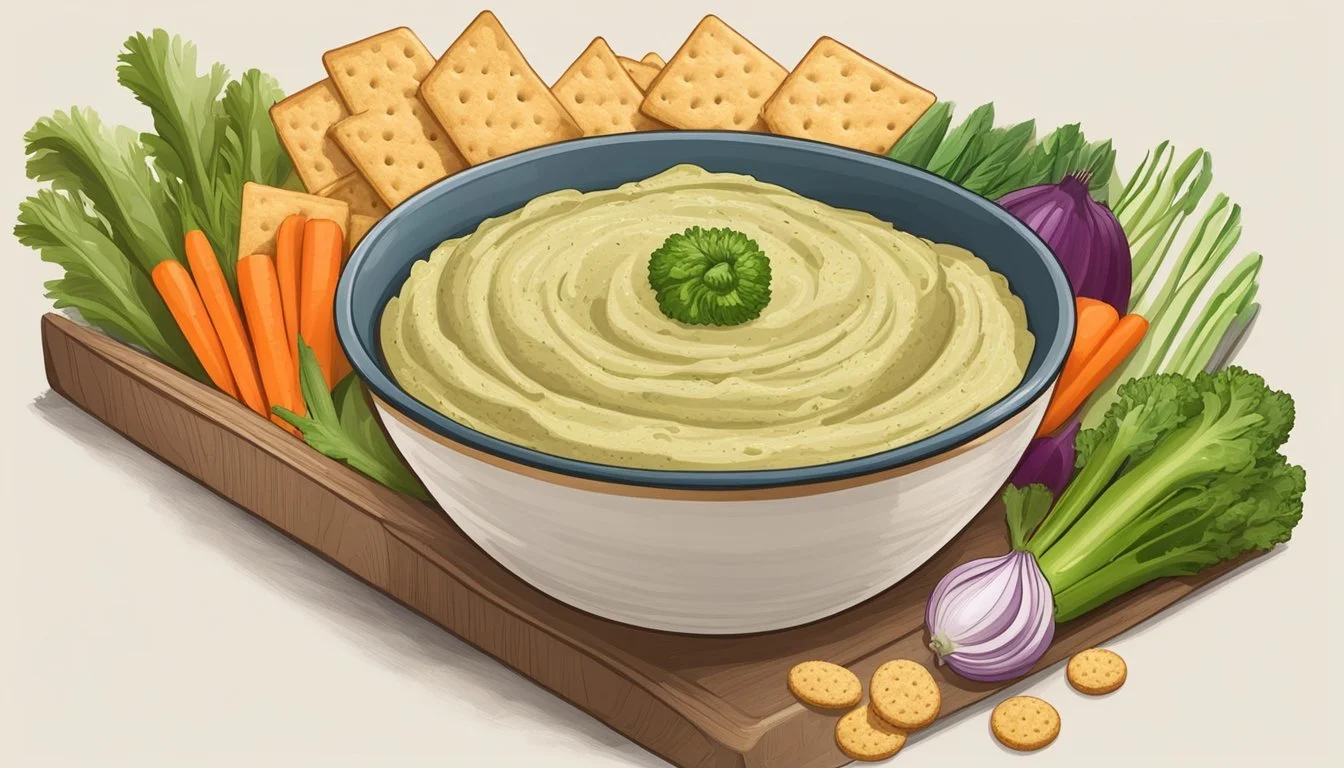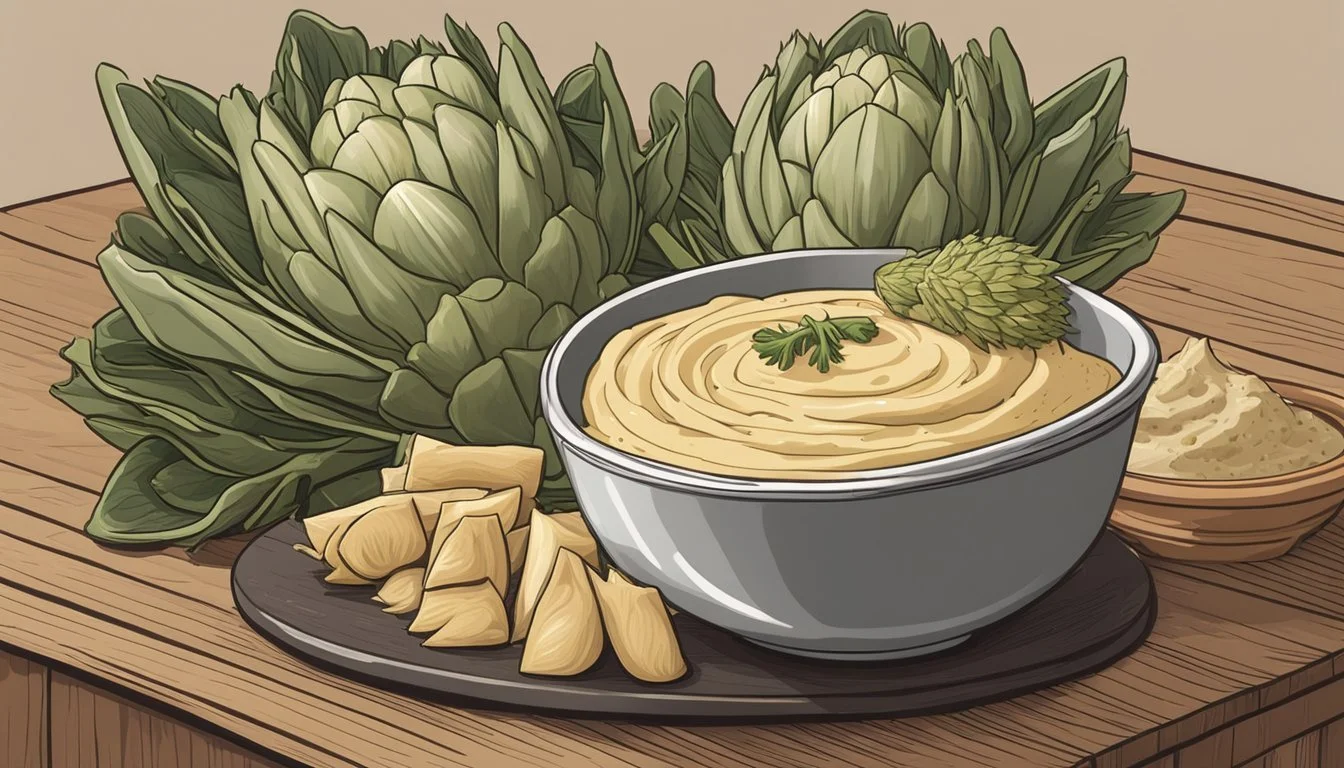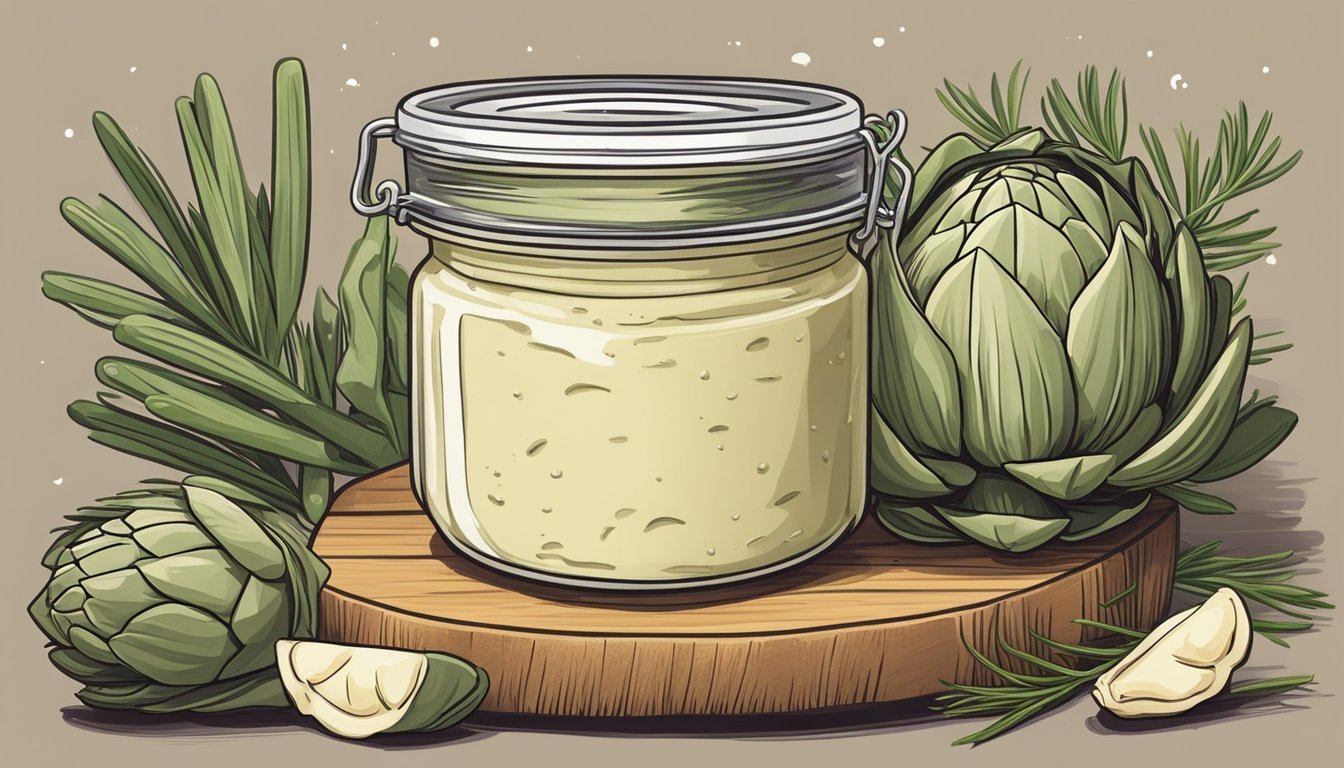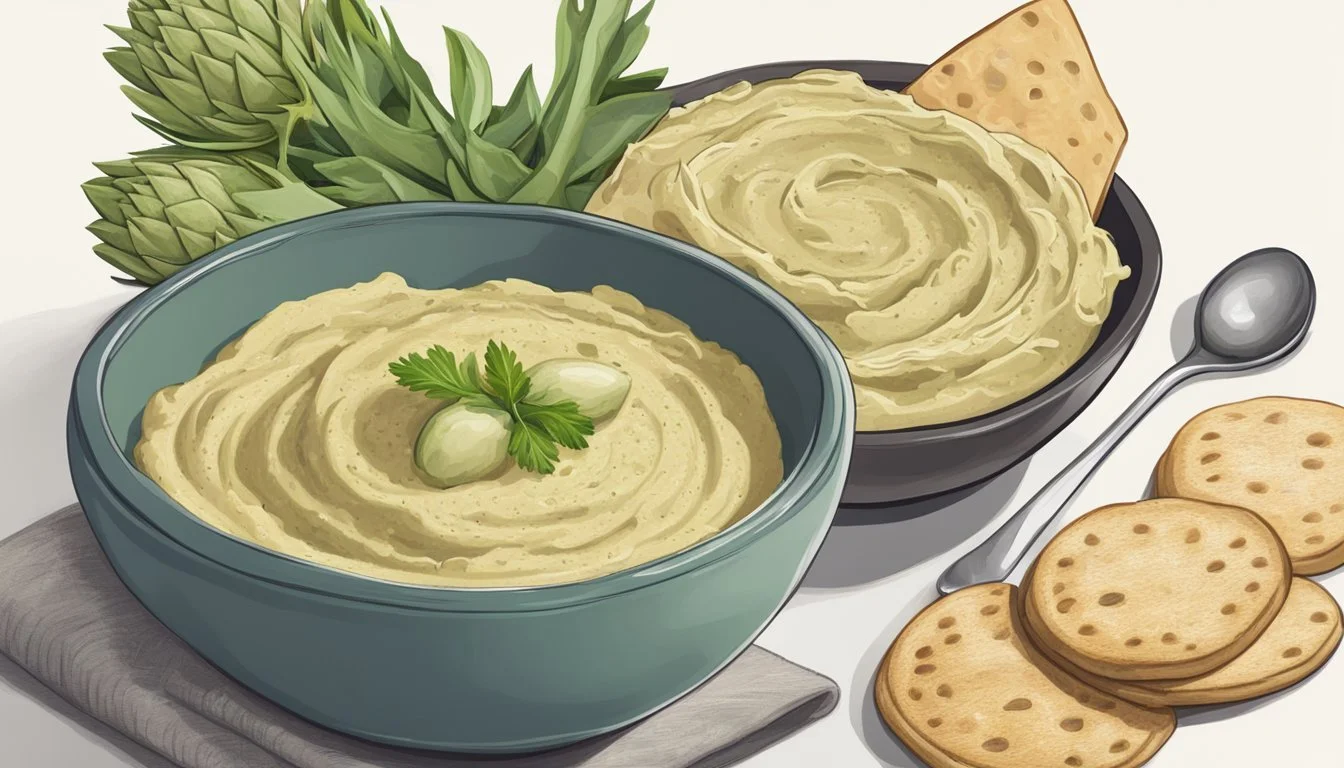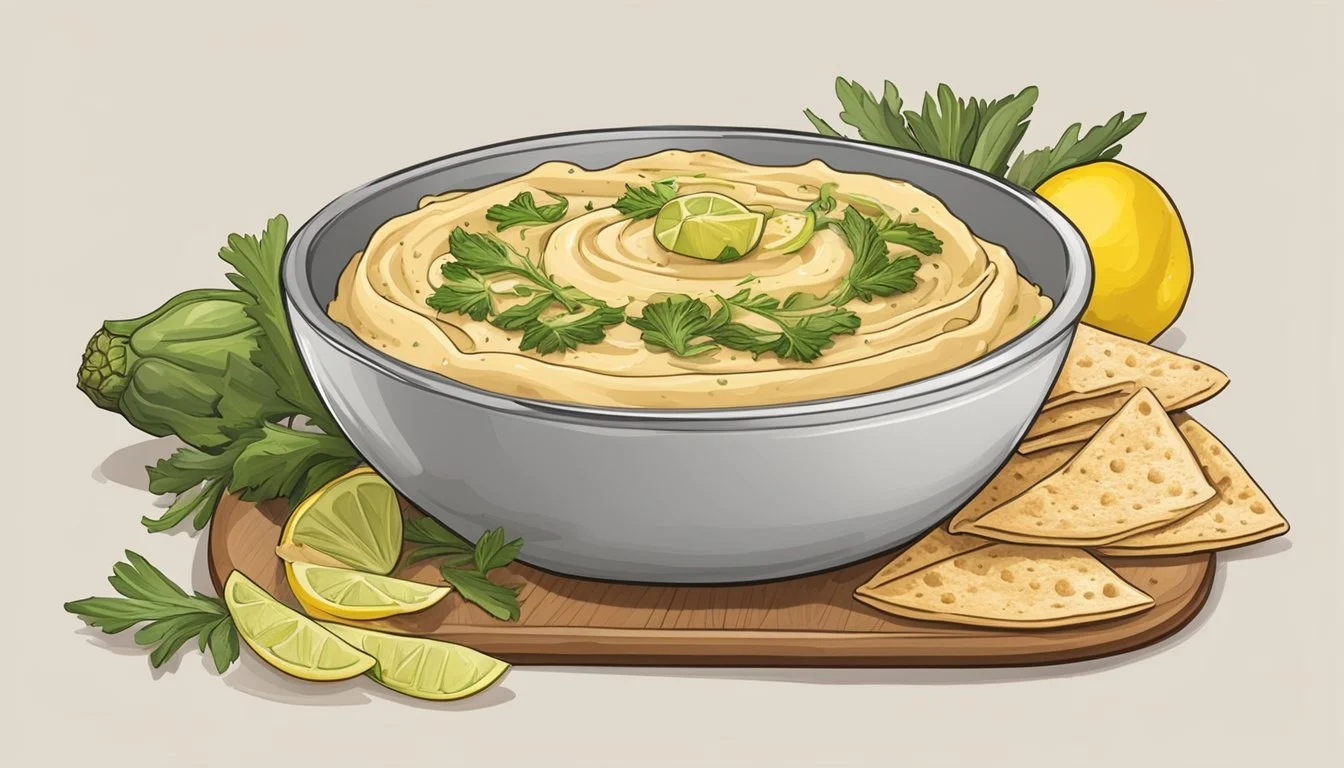Artichoke Stem Hummus
A Nutritious Twist on a Classic Appetizer
Artichoke stem hummus is a twist on the traditional Middle Eastern spread, introducing a novel ingredient that not only reduces waste but also enhances the nutritional profile of the dish. Often discarded, artichoke stems are packed with fiber and flavor, making them an ideal addition to hummus. This version maintains the creamy texture that hummus lovers crave, while also providing a subtle, nutty undertone from the artichoke stems which complement the classic combination of chickpeas, tahini, and lemon juice.
The preparation of artichoke stem hummus mirrors the traditional process, utilizing a food processor to blend the ingredients into a smooth, delectable dip. The key to its creaminess lies in the incorporation of the fibrous stems, which are pureed along with the other components. Seasoning adjustments and additional ingredients like garlic, salt, and olive oil are made to taste, ensuring that the final product is not only rich in fiber but also in flavor.
This fiber-rich dip offers a healthy, satisfying option for snacking or as part of a meal. It serves as a versatile accompaniment to a variety of dishes, pairing well with raw vegetables, pita chips, or as a flavorful spread for sandwiches and wraps. Artichoke stem hummus invites both hummus aficionados and newcomers to explore a more sustainable, nutritious, and equally delicious version of the beloved classic.
Health Benefits of Artichoke Stem Hummus
Artichoke stem hummus combines the nutritional density of artichokes (What wine goes well with artichokes?) with the creamy and versatile characteristics of traditional hummus. Ready to be spread on toast or served as a dip, this culinary invention delivers health benefits that cater to various dietary needs.
Nutritional Profile
Artichoke stems are often discarded, yet they possess a nutrient-rich profile similar to the rest of the plant. In a serving of artichoke stem hummus, one finds an abundance of vitamins, minerals, and fiber. Artichokes contribute notably to the intake of:
Fiber: Essential for digestive health.
Vitamin C: Important for immune function and skin health.
Minerals: Magnesium, potassium, and copper, among others.
Protein: Offers a plant-based source, particularly valuable for vegan diets.
Weight Management and Satiety
The fiber content in artichoke stems is excellent for weight management. Due to its ability to slow digestion, fiber contributes to feelings of fullness and reduced appetite, potentially leading to lower caloric intake throughout the day. A low-carb and low-calorie profile makes artichoke stem hummus a favorable option for those monitoring their weight.
Digestive Health
Artichokes rank highly as a food source for dietary fiber, a component crucial to digestive health. Fiber aids in regular bowel movements and can help to prevent constipation. Additionally, artichoke stem hummus is a good match for those seeking anti-inflammatory benefits, as the fiber and nutrients within can support gut health and reduce inflammation.
Key Ingredients and Substitutes
In crafting a creamy Artichoke Stem Hummus, attention to ingredient quality and an understanding of potential substitutes is vital to maintaining both the health benefits and the robust flavors of this plant-based dip.
Artichokes and Their Health Benefits
Artichokes, the star of this dip, are not only flavorful but also packed with fiber and antioxidants. They are a good source of vitamin C, vital for immune function. For those who cannot find fresh artichokes, canned or frozen artichoke hearts are a convenient substitute that still delivers the fiber-rich benefits artichokes are known for.
Fresh Artichokes: High in fiber and nutrients
Canned/Frozen Artichoke Hearts: A quicker, still nutritious alternative
Protein Sources in Vegan Hummus
Traditional hummus calls for chickpeas as its primary protein source, essential in a vegan recipe. Chickpeas offer a smooth texture and are a great source of plant-based protein. For variety, white beans or black beans can be used, each offering a unique flavor and texture profile.
Chickpeas: Classic choice, providing a smooth base and protein
White Beans: A creamier texture and higher fiber content option
Black Beans: For a twist with different antioxidants
Key ingredients such as tahini—a paste made from ground sesame seeds—add richness and are fundamental to hummus. Lemon juice adds brightness and acidity, balancing the flavors. Garlic lends a pungent depth, while olive oil contributes to the creamy texture. Cumin and other spices can offer depth and complexity to the dip. For those seeking a cheesy flavor without dairy, nutritional yeast can be a flavorful vegan substitute. Each component plays a role in creating a harmonious and healthful dip that is as nutritious as it is delicious.
Preparation Techniques
When creating Artichoke Stem Hummus, one's focus should be on achieving a creamy texture and fully integrating the fibrous stems. Both kitchen equipment and technique play crucial roles.
Using a Food Processor
Texture: The food processor is the ideal tool to ensure a smooth consistency. It effortlessly grinds the artichoke stems, which are harder than the leaves.
Procedure: Begin by placing the cooked or canned artichoke stems into the food processor. Add other ingredients, such as chickpeas, tahini, garlic, and lemon juice. Pulse until the mixture starts to become smooth. For additional creaminess, a drizzle of olive oil while the machine is running helps emulsify the hummus and refine its texture. Periodically stop to scrape down the sides of the bowl, ensuring all ingredients are well-incorporated.
No-Cook Options
Blender Utilization: A high-powered blender can be a no-cook option but might require more liquid to achieve a similar creaminess compared to a food processor.
Microwave Pre-treatment: For canned chickpeas, a brief warming in the microwave with baking soda can soften them. This makes blending easier, especially if a food processor is not available. Rinse the heated chickpeas and proceed to blend with the artichoke stems and other components.
Flavor Enhancements
Artichoke stem hummus can be transformed into a flavorful symphony by introducing select herbs and spices, utilizing a range of acidic components to add zest, and incorporating extra ingredients to achieve the perfect creamy consistency.
Herbs and Spices
To elevate the taste profile, one can infuse the hummus with a variety of herbs and spices. Classic seasonings such as cumin and oregano introduce earthy notes, while a pinch of red pepper flakes offers a subtle heat. Rosemary adds a distinctive, aromatic touch that complements the artichokes. Here's a simple guide:
Parsley: Fresh and bright; chop finely and mix in to taste.
Cilantro: Adds a citrus-like dimension for those who enjoy its vibrant flavor.
Cumin & Oregano: Ground, start with 1/2 teaspoon each and adjust according to preference.
Acidic Components
The right touch of acidity can sharpen and define the other flavors in the hummus. Lemon juice is a classic choice, bringing a fresh citrus profile that pairs excellently with artichokes. For a more nuanced tang, balsamic vinegar can be a compelling addition:
Lemon Juice: Squeeze to taste, typically starting with the juice of half a lemon.
Balsamic Vinegar: Drizzle a teaspoon initially and adjust to your preference.
Extra Ingredients for a Creamy Texture
A smooth and creamy texture is a hallmark of great hummus. Beyond the traditional use of tahini, one can consider integrating greek yogurt, cream cheese, or sour cream for a richer consistency. For a vegan recipe, additional tahini or even a splash of the chickpea canning liquid, known as aquafaba, enhances creaminess without dairy. The following ingredients can be mixed in to achieve desired creaminess:
Tahini: Add more in small increments, checking for both flavor and texture.
Vegan Alternatives: Incorporate small amounts of aquafaba or additional olive oil.
By attentively balancing these elements, the artichoke stem hummus is not only delicious and creamy but also layered with a complexity of flavor profiles.
Serving Suggestions
Artichoke stem hummus, with its creamy consistency and dietary fiber, becomes a versatile component in both casual and sophisticated dining settings. This dip is not only fresh and flavorful but also pairs exceptionally with a variety of snacks and can be incorporated into numerous meal preparations.
Appetizer and Snack Ideas
One can never go wrong with artichoke stem hummus as an appetizer. It invites a party of flavors when served alongside:
Tortilla chips: Offer a warming crunch that complements the smooth texture of the hummus.
Carrot sticks and bell pepper strips: These veggies introduce a satisfying crispness and a pop of color.
Broccoli and cauliflower florets: Their earthy notes make for a delightful contrast with the hummus.
Whole grain crackers: They provide a hearty, robust base for the creaminess of the dip.
Jicama sticks: Add a mild, sweet crunch that meshes well with the hummus.
These options present a fresh, inviting snack that caters to a range of tastes and dietary preferences.
Creative Uses in Meals
Artichoke stem hummus can be much more than a simple appetizer or snack. It also serves as an innovative ingredient in meals:
Hummus Pasta: Stirring the hummus into warm pasta creates a creamy, flavorful sauce that’s both satisfying and nourishing.
Stuffed Bell Peppers (What wine goes well with stuffed bell peppers?): Fill bell peppers with a mixture of hummus and other ingredients, then bake until tender.
Sandwich Spread: Swap out traditional condiments for a thick layer of hummus to add depth to sandwiches and wraps.
By incorporating artichoke stem hummus into various dishes, one elevates the dining experience with a gourmet touch that is as delicious as it is health-conscious.
Customization and Variations
Artichoke stem hummus can be tailored to fit a variety of dietary needs and taste preferences. Discover how to modify this healthy dip to suit vegan lifestyles, add colorful twists, and incorporate bold flavors.
Adjusting for Dietary Restrictions
Vegan and Vegetarian: Artichoke stem hummus is naturally plant-based, making it an excellent choice for vegans and vegetarians. To ensure it stays vegan-friendly, use dairy-free and gluten-free ingredients, particularly when choosing flavor add-ins like nutritional yeast in place of cheese for a cheesy flavor.
Gluten-Free: This hummus variation is intrinsically gluten-free. However, it's crucial to verify that all additional ingredients, such as spices and flavor enhancements, do not contain gluten.
Colorful and Textured Variants
To infuse color and additional textures into artichoke stem hummus, one can incorporate a variety of vegetables.
Spinach Artichoke Dip: Adding defrosted and drained spinach to the traditional artichoke hummus recipe enriches it with a vibrant green hue and a familiar, comforting flavor.
Roasted Beet Hummus: Incorporate pureed roasted beets for a visually striking, deep red hummus loaded with nutrients.
Green Goddess Hummus: Blend in fresh herbs like basil, parsley, and cilantro for an herbaceous and brightly colored variant.
Spicy and Savory Twists
For those who prefer a bolder taste, several ingredients can be added to create a variety of spicy and savory profiles:
Roasted Red Onion and Bell Peppers: Adding roasted vegetables such as red onion and bell peppers brings a smoky and savory sweetness to the hummus.
Red Pepper Flakes or Smoked Paprika: A dash of red pepper flakes introduces a subtle heat, while smoked paprika offers a smoky depth to the dip.
By incorporating these ingredients, artichoke stem hummus can be customized to satiate any palate, with variations that are as nutritious as they are flavorful.
Storing and Preserving Artichoke Hummus
Proper storage of artichoke hummus extends its freshness and maintains its creamy texture. Knowing how to refrigerate and freeze this fiber-rich dip is essential for preserving its quality.
Refrigeration Tips
To keep artichoke hummus fresh in the refrigerator, follow these specific guidelines:
Immediate Storage: Transfer hummus to an airtight container promptly after preparation or opening.
Temperature: Store the container at or below 40°F (4°C) to prevent bacterial growth.
Duration: Homemade artichoke hummus should be consumed within 5 to 7 days, while store-bought versions may last up to 10 days, depending on the presence of preservatives. Always check the 'best by' date for a more accurate timeframe.
Avoid Cross-Contamination**: Use clean utensils each time to scoop out the hummus to prevent spoilage.
Freezing and Thawing Hints
Artichoke hummus can be frozen, though this may slightly alter its texture:
Freezing: Place the hummus in a freezer-safe container, leaving some space for expansion. Seal tightly and label with the date.
Storage Period: Properly stored, frozen artichoke hummus can last for up to 4 months in the freezer.
Thawing: To thaw, transfer the container to the refrigerator and let it defrost slowly, preferably overnight.
After Thawing: Once thawed, stir the hummus to restore its creamy consistency. Consume the defrosted hummus within 3 days and do not refreeze.
By adhering to these storage and preservation tips, one ensures that leftovers maintain their desirable qualities until the next serving.
Nutritional Information and Calorie Count
Artichoke stem hummus is a variant of the classic hummus dish, incorporating the often-discarded stems of artichokes. This creamy dip is not only a savory treat for the taste buds but also a nutrient-rich option for health-conscious individuals.
A typical serving size of artichoke stem hummus can be approximately one tablespoon (15 grams). This serving might contain around:
Calories: 39
Protein: 1.2 grams
Carbohydrates: 3 grams
Fats: 2.7 grams
Fiber is a significant component in this hummus due to the artichoke stems, which are naturally high in dietary fiber. Including fiber in one’s diet aids in digestion and can contribute to a feeling of fullness.
The protein content, while modest, is essential for muscle repair and growth. Artichoke stem hummus also commonly includes ingredients such as chickpeas and tahini, which further contribute to its protein content.
In terms of vitamin C and minerals, artichokes are known to be a good source, and their inclusion in the hummus enhances its nutritional profile. Vitamin C is vital for a robust immune system and skin health, whereas minerals, such as potassium found in artichokes, play a crucial role in maintaining fluid balance and heart function.
Here is a breakdown of the nutritional benefits:
Nutrient Amount per tablespoon (approx.) Calories 39 kcal Protein 1.2 g Fiber Varies, but artichokes are high in fiber Vitamin C Present (in smaller quantities) Minerals Includes potassium
It's worth noting that the exact values can vary based on the specific ingredients used and their proportions in the recipe. Artichoke stem hummus stands out as a flavorful and healthy choice for those seeking a dip that supports dietary well-being.
Step-by-Step Recipe: Artichoke Stem Hummus
Artichoke Stem Hummus fuses the creamy texture of traditional hummus with the unique taste of artichoke stems, offering a fiber-rich and deliciously savory dip. This section walks readers through the creation process, from the gathering of ingredients to serving, ensuring a flavorful experience with every step.
Gathering Ingredients
Before one begins, it's essential to prepare the following ingredients:
1 cup artichoke stems, cooked and chopped
1 can (15 oz) chickpeas, drained and rinsed
2 tbsp tahini
2 cloves garlic
Juice of 1 lemon
2 tbsp olive oil
1/2 tsp salt
1/4 cup reserved chickpea liquid (aquafaba) or water
Fresh spinach, parsley, or rosemary for garnishing
Mixing and Blending
To achieve a smooth consistency:
Place the cooked artichoke stems, chickpeas, tahini, minced garlic, lemon juice, and salt in the bowl of a food processor.
Pulse the ingredients until coarsely chopped and then blend on a continuous setting.
While blending, slowly drizzle in olive oil and aquafaba until the hummus reaches the desired creamy texture.
Scrape down the sides of the bowl occasionally with a spatula to ensure even blending.
Taste the hummus and adjust seasoning if needed.
Serving and Garnishing
For an appetizing presentation:
Transfer the blended hummus to a serving bowl.
Create a shallow well in the center and pour a small amount of olive oil into it.
Garnish with finely chopped fresh spinach, parsley, or rosemary.
Serve the hummus with an array of colorful vegetables, warm pita bread, or crackers.
This hummus recipe offers not only an easy and delicious dip but also a versatile garnishing palette to impress anyone's palate.
Frequently Asked Questions
This section is designed to address common concerns and explore various recipe variations for creating a creamy Artichoke Stem Hummus. It will provide readers with essential information on how to tailor the hummus to their dietary needs and how to store it properly.
Common Concerns
Is Artichoke Stem Hummus vegan and gluten-free? Artichoke Stem Hummus is inherently vegan as it contains no animal products. Its main ingredients include artichoke stems, chickpeas, tahini, lemon juice, and seasonings, all of which are plant-based. It is also naturally gluten-free, making it suitable for those with gluten sensitivities or celiac disease.
Can Artichoke Stem Hummus provide a good source of protein? Chickpeas, the cornerstone of any hummus, are rich in protein, which makes Artichoke Stem Hummus a protein-packed snack. By incorporating the fibrous stems of artichokes, one also benefits from additional fiber.
How long can this hummus last in the freezer? When stored properly in an airtight container, Artichoke Stem Hummus can last in the freezer for up to four months. To ensure best quality and flavor, they should defrost it in the refrigerator and consume within 24 hours.
Recipe Variations
How can I use Artichoke Stem Hummus in different dishes?
Hummus Pasta: Mix this hummus with some pasta for a creamy sauce.
With Dairy: For those who are not vegan, parmesan or feta could enhance the flavor.
As a Spread: Perfect for sandwiches and wraps, providing a fiber-rich alternative to traditional spreads.
What are some ingredient substitutions for dietary preferences or restrictions?
Tahini Alternatives: For those allergic to sesame, sunflower seed butter or almond butter could be used.
Oil-Free Version: To reduce fat content, one can substitute the olive oil with aquafaba, the liquid from canned chickpeas.
By understanding these factors, one can enjoy a satisfying and versatile Artichoke Stem Hummus that caters to a variety of dietary needs and preferences.
Multimedia Resources
Artichoke stem hummus is garnering attention for its creamy texture and fiber content, and there are multimedia resources available that can help enthusiasts perfect their dip-making skills. These resources provide visual guidance and step-by-step instruction.
Cooking Videos
YouTube is an excellent platform for cooking tutorials, and several channels specialize in creating dips. Viewers can find cooking videos that demonstrate how to prepare artichoke stem hummus, presenting the techniques and tips to achieve the perfect consistency. These videos serve as a comprehensive visual guide, allowing viewers to follow along at their own pace.
Example Channels:
Chefs Tabletop: Offers high-definition videos featuring professional chefs illustrating the art of hummus making.
Home Cooking Academy: Shares easy-to-follow videos targeted at home cooks looking to expand their repertoire of healthy dips.
Photo Galleries
For those who prefer a quick visual reference without following a full video, photo galleries present a sequence of high-quality images showing each step of the artichoke stem hummus preparation process.
Benefits of Photo Galleries:
Quick Reference: Allows cooks to quickly check a particular step or ingredient.
No Audio Needed: Ideal for situations where watching a video isn't feasible due to noise constraints or data usage concerns.
By utilizing these multimedia resources, individuals can enhance their culinary skills and produce a rich, flavorful artichoke stem hummus.

